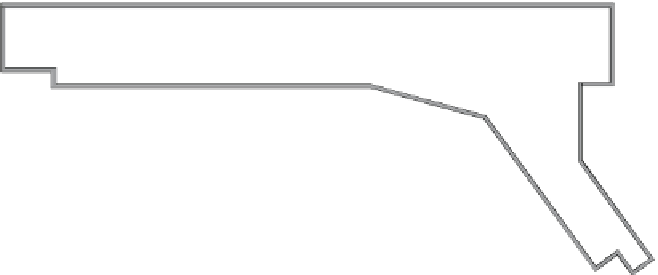Geoscience Reference
In-Depth Information
Alpbach
1
1
14
5
8
16
1
0
MID
4
3
2
1
12
13
9
7
6
15
1
water inlet
9
sediment chute
sediment trap with
weighing cells
ultrasonic systems
Milibach
magnetic inductive flow
control (MID)
laser system
2
10
1
mobile hook gauge
flood wall
2
3
4
3
manual valve
11
outlet basin
4
pneumatic disk valve
12
overflow weir
regulable pump
x-y positioning system
computer
water returnback
houses
5
inlet basin
sediment loading machine
sediment retention basin
dam
13
bridges
model scale
5
6
14
6
0m
1m
7
15
0m
30m
8
16
natural scale
Fig. 3 Physical model of the torrent Alpbach and torrent Milibach
investigated. In this chapter, however, the focus is on the modeling of bed load,
other aspects and results of the model are just briefly mentioned.
The physical model has been built with Froude similitude and a scale of 1:l with
l
35. The project perimeter includes the Alpbach from the end of the sediment
retention basin and the Milibach from the beginning of the entrance to the populated
area and is in nature about 35 m wide and 700 m long (Fig.
1
). The model itself is
about 10 m wide and 21 m long, including the two inlet basins for the Alpbach and
Milibach (Fig.
3
(5)) as well as the outlet basin (Fig.
3
(11)).
A particular characteristic of the physical model of Meiringen is given by the
distinct water and sediment hydrographs of the Milibach and Alpbach. In order to
run these hydrographs, discharge and sediment input are PC-controlled by regulat-
ing the gate valve of the intake (Fig.
3
(4)) and the sediment loading machine (Fig.
3
(6)), respectively. The sediment is added to the channels in a short distance
downstream of the water inflow.
The outlet basin is situated where the Alpbach meets the river Aare (Fig.
1
). The
water level in the outlet basin is controllable by a regulated pump (Fig.
3
(13)) and
an overflow flap gate (Fig.
3
(12)) to guarantee a constant Aare water level while
simulating a flood hydrograph. This allows investigating the effect of backwater
into the Alpbach.
The transported sediment that reaches the outlet basin is forwarded by a chute
(Fig.
3
(9)) into a submerged sediment trap (Fig.
3
(10)). This trap is connected to
three weighing cells allowing continuous measuring of sediment output, analogue
to Tamagni et al. (
2008
). The sediment input to the model is continuously measured
by the loading machine and recorded. The deposition in the Alpbach is measured by
scanning the channel after every experiment with a laser distance meter mounted on
an automatic
x
-
y
traversing system (Fig.
3
(14)). Deposition in the Milibach and
sediment which overtopped the banks and deposited beyond the channels are
¼



































































































































































































































































































































































































































































































